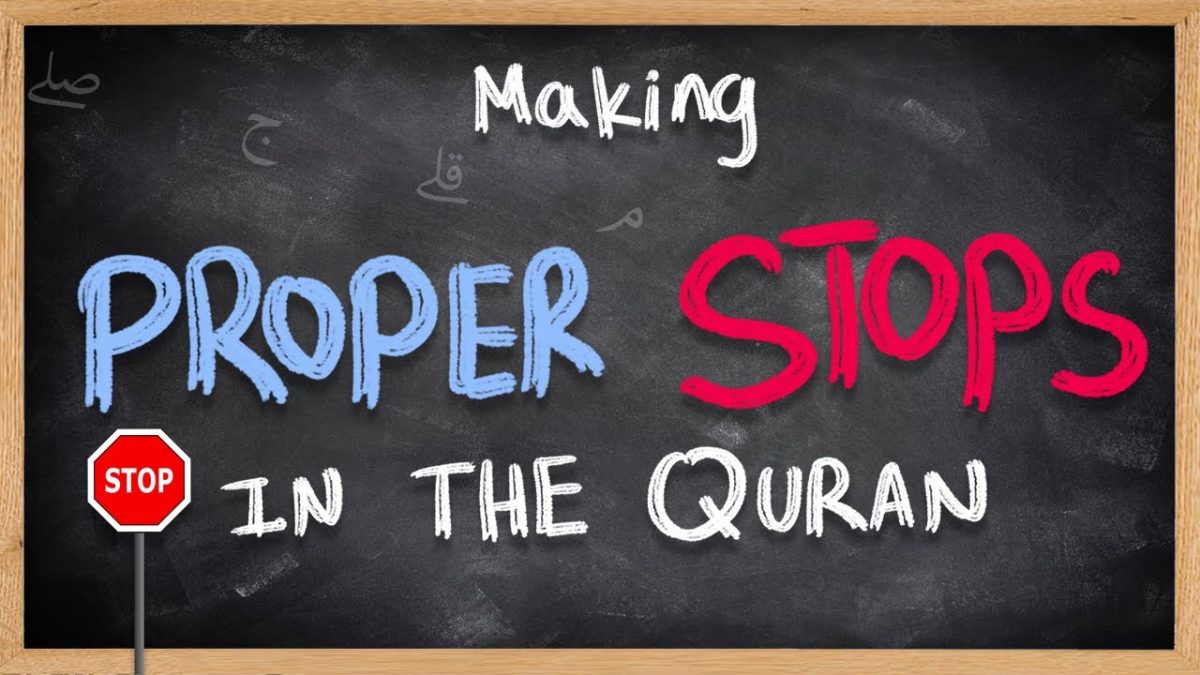Rules Of Stopping In Quran
Table of Contents
ToggleReading the Qur’an is one thing, and reciting it correctly is something completely different. If you are not familiar with the basic rules of recitation, you are probably not doing it right.
Are you aware of the signs and symbols above some words? Its meaning, purpose and importance?
If you want to learn to recite the Qur’an, you need to understand and follow the rules of the Qur’anic recitation of pauses, stops, starts, and cut-offs. Thus, today Mishkah Academy presents you with the important and basic rules of Quran recitation.
It is our duty to learn all the rules of Quran recitation so that we can read it in the right way and apply its teachings to please God Almighty. Let’s learn the rules of stopping and Pausing when reading the Quran and knowing all kinds of stopping in the Quran for better recitation.
Allah The Almighty said:
“And recite the Qur’an with a chant”, i.e., do not rush to read the Qur’an, but rather read it slowly and clearly while reflecting on the meanings.
Messenger of Allah (PBUH) said:
“The one who is proficient with the Qur’an will be with the noble and righteous scribes (the angels), and the one who reads it and stumbles over it, finding it difficult, will have two rewards.”
Ibn Al-Jazari also “Most Famous Tajweed Scholar” said:
“The practical application of Tajweed is without doubt compulsory. Who does not read the Quran correctly is a sinner”.
Before we shed light on Stopping Signs Rules and dive into the practice comprehension of its rules, it is also recommended to read the Great Benefits Of Learning Tajweed Quran, as they are also very important an crucial.
Hence, putting How To Learn Tajweed Rules, including Rules Of Stopping In Quran, a priority and giving it its dues effort and time is of great importance. Also, understanding our responsibilities so that we can receive his mercy is of our greatest duties.
Before we clarify Stopping Signs In The Quran, check this inspiring article to know How To Learn Tajweed Quran and apply its rules when reciting the Holy Quran.
Join thousands of Muslim Families who love learning Quran, Arabic and Islamic Studies from the comfort of their Homes.
Learn Quran, Arabic & Islamic Online
Best Online Tajweed Course
Importance of the Rules of Stopping When Reading Quran
The benefits of learning Tajweed and the rules for pausing when reading the Qur’an literally are countless. Knowing the proper places to start and the rules for stopping when reading the Qur’an is very important so that we do not make fatal mistakes in pronunciation or change the entire meaning.
Moreover, the Prophet Muhammed, may God bless him and grant him peace, strongly encouraged us to give the Quran its due effort and respect saying:
“The best among you (Muslims) are those who learn the Quran and teach it”
Stop Rules In Quran
Let’s start with the basic rules of Quran recitation. Many people are ignorant of the basic symbols and signs they see in the Qur’an. Hence, here are the basic rules and symbols of Quran recitation that you guys must know.
Stop And Pause Signs In Quran

Quran Symbols Meaning In English
– The Conclusion of Verse
“Waqf e Taam” represents the final end of a particular verse from Furqan Hameed. It is also known as the perfect stop. It is represented simply by a circle at the end of the Qur’anic line. The reader should stop here and take a breath before continuing on.
مـ – The Compulsory Stop
The sign of “Waqf e Laazim” bounds the reciter or the qari to stop recitation at certain point, as the word laazim means mandatory. It is so because if one does not stope or pause thereon, the entire meaning of the sentence will alter radically.
ج – The Permissible Stop
“Waqf e Jaaiz” points toward the completion of the matter discussed in that passage of the verse, one needs to pause here, though it is not obligatory, in order to comprehend the meaning discussed in the previous part, and prepare to become acquainted with the new matter in the verse. The next part of the same verse.
صلي– Preference for Continuation
“Al-wasl Awlaa” indicates towards continue recitation of the verses with no need to stop.
قلي – Better not to Stop
“Qeela ‘Alayhil-Waqf” is a sign that shows not to stop recitation although there are differing opinions on whether to stop reading the verses or not.
س – The Silence Symbol
“Saktah” is a sign at which the reader should take a brief pause without breaking its breath before keeping on reading further.
لا – No Need of Stopping
One should not stop reading on this sign of “Laa” as it would change the meaning of Quranic lines altogether, yet one can stop when it is used at the end of the Ayah with Circle Mark of conclusion.
∴ – The Embracing Stop
“Mu’aanaqah” is a sign that signifies about stopping at either of the triplet included in it, with no discontinuation simultaneously.
Final Words
In conclusion, after such a long journey, you must have patience in reading the Quran. Remember that as long as you are doing your best to learn and improve your recitation, you are on the right track. Success is persistence. Always keep in mind that learning Tajweed is a gateway to understanding the Quran to apply it. The app is the cornerstone.
Every Muslim desires to learn the Holy Quran. But if you are reading the Holy Quran but you are ignorant of the main rules of Quran recitation, then there is no need for that. With Mishkah Academy, you can now enroll in our online Tajweed course and start learning all the rules of Tajweed, including the rules for stopping when reciting the Quran.
Start Your Tajweed Journey Now
You May Like To Read
Recommended Courses
Quran Recitation With Tajweed Course
FAQs
Importance Of Stopping Signs & Symbols In Quran
Each language in its form and structure is characterized by some specific rules and instructions for its use. The divine language of the Holy Quran has its own principles that every reader must pay attention to while reciting the Holy Quran. That is why the Qur’anic verses contain some necessary stop and pause signs that are necessary so that the reader can understand their meaning in the correct way, and learn to recite the Qur’an with the correct tajweed rules.
When To Stop And Pause In Quran Reading
First of all, let us understand the definition of waqf before we explain the rules for stopping when reading the Quran. The linguistic definition of Waqf is stopping. For its applied definition: It is cutting off the sound at the end of a word, usually for a period of breathing time, with the intention of returning to the recitation, not with the intention of finishing it. It could be at the end of a verse or even in the middle. However, it cannot be in the middle of a word.
When To Stop While | When Reading Quran
As well as learning the rules of stopping when reading Quran, It is important to know how to stop on any word. Whether at the end of verses or phrases, or merely to take a breath.
Where To Stop And Pause In Quran
Quran Stops And Pauses
ج permissible stopping.
صلي Peferred to stopp.
قلي Peferred to continue.
لا Must Continue.
مـ Compulsory stopping.
∴ ∴ Stop on 1 out of 2.
Quran Stop Pause Marks
ج – Permitted stop.
قلي – Better to pause.
قلي – Better not to pause.
م – Necessary stop.
لا – Forbidden stop.
س – Pause without breathing.
∴ ∴ – Stop at one of them.
Quran Symbol
The Quran has numerous symbols, important to the understanding of the scripture and the Islamic faith. These symbols include imagery, stories, and themes that serve to transmit and reflect the deepest meanings and values of the Quran.
The Quran uses a variety of other symbols to convey its message, such as light and darkness to represent good and evil, and the concept of mercy as a sign of God’s love and benevolence.
The Quran contains numerous symbols that have deep meanings, serving as a source of guidance and inspiration for Muslims around the world.
The Quranic symbols and their meanings continue to inspire Muslims towards meaning in their faith, which is a great benefit of the holy book.
Understanding these symbols is essential in interpreting and comprehending the Quran’s message and the Islamic faith.
Quran Stop Signs
- مـ compulsory stop to avoid altering the meaning. It’s an indicator for the required stop.
- ط normal stop at the end of a sentence or thought
- ج permissible stop. It’s an indicator for the sufficient stop.
- صلي (or ز) permissible stop but preferable to continue. It’s an indicator for the good stop.
- قلي permissible to continue but preferable to stop. It could be an indicator for a complete or sufficient stop.
- لا either not to cut off the recitation, or not to stop on the marked word and start on the following word. It’s an indicator of the repulsive stop.
- قف The Anticipation Mark: preferable to stop.
- ∴ – The Embracing Stop: “Mu’aanaqah” is a sign found twice on two words from the Ayah, meaning if you want to stop on one of them, then you are not allowed to stop on the other. However, it’s permissible to continue without stopping on any of them as well.



























